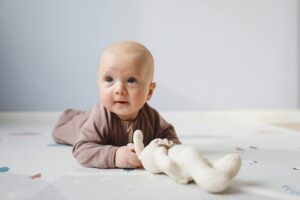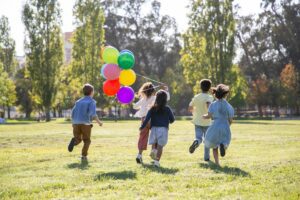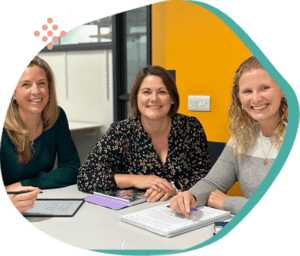There was much surprise in one of our local primary schools when the children who were meant to be getting support with their handwriting were seen propelling themselves along the corridor whilst lying on skateboards!
So what has skateboarding, dancing and simply running free got to do with how well a child can write? Well, it turns out, quite a lot actually!
Read on to find out how physical activity can develop children’s academic development, concentration and attainment in the classroom.
Starting early
Developing the muscles needed for children to draw, write and simply sit at a desk, starts much earlier than you might think.

Introducing supervised tummy time for babies from just a few months old helps to strengthen their back, neck, and shoulder muscles. These muscles are crucial for general coordination and the development of fine motor skills, which are essential for later school-based tasks such as holding a pen or sitting correctly.
We can’t get away from the fact that we are living in an increasingly sedentary world. Little ones are often moved from highchairs to bouncers to car seats without the freedom to experience the chance to sit unaided, roll or try out some tummy time. As a result, the muscles used to support fine motor skills haven’t sufficiently developed by the time the children reach school age.
This is where the skateboards come in! Whilst gross motor skills are most commonly associated with physical activity such as running and jumping, they are also needed for simply sitting still, a requirement in every mainstream classroom across the UK.
Using the skateboards allows children to strengthen their neck, shoulder and arm muscles making it easier for them to develop postural control, sit at the school desk and hold a pencil in the correct way all at the same time.
Stand up, sit down, keep moving
Children are essentially fighting gravity when they are still learning how to control their limbs! It takes a surprising amount of muscle control and coordination just to be able to sit on a chair with their feet on the floor and a pen in their hand.
The more developed their muscles through play and exercise, the easier they’ll find it to sit still and maintain postural control.
Movement also helps children manage their energy levels and emotions. Physical activity can reduce stress, anxiety, and behavioural issues, promoting a positive emotional state, meaning they are more likely to be able to concentrate and, even more importantly, enjoy their lessons.
You move, you learn!
A study published in the Journal of Paediatrics found that children who were physically active showed better academic performance and cognitive function compared to their less active peers.
We all know that physical activity increases blood flow to the brain. This can enhance cognitive function and academic performance. A good run around in the yard will support brain growth and development, particularly in areas related to memory, attention, and problem-solving.
It’s not just about ensuring that children are active during playtime or P.E lessons, however. Quick bursts of movement in between sedentary learning, help to keep children attentive and focused. Integrating physical activity into classroom-based learning not only makes lessons more engaging but can also help reinforce academic concepts.
We all stand together
No child is born knowing how to share or cooperate. Just like reading or writing, these are skills that need to be taught.
Through physical play and group activities, children can learn to resolve conflicts and navigate social dynamics.

Group activities such as sand games, building challenges or relay races promote teamwork, social interaction, and effective communication with their peers.
Putting theory into motion
There are only so many hours in the day and it can be difficult to plan meaningful physical development opportunities that will actually impact positively on the children. At ASK, our team of occupational therapists and psychologists offer training in Movement Matters for schools and staff to help build impactful movement activities into the classroom routine.
There are also some small but mighty tips and tricks to get you started:
- Give children brain breaks: Short breaks involving physical activity can help reset children’s attention and improve their ability to focus on tasks.
- Incorporate flexible seating and movement-friendly spaces: Creating an environment that allows for movement, such as using standing desks or having open spaces for activities, can support an active learning environment.
- Reward physical achievement as much as academic success: Successfully participating in physical activities and achieving movement-related goals can boost a child’s confidence and self-esteem. Ensure that such achievements are recognised and praised.
- Hands as well as feet: children need to physically explore with their hands as well as run around on their feet. Allow opportunities for tactile and sensory exploration, using materials such as sand, water and clay.
There are so many obvious benefits to getting children moving that go beyond physical health and strengthening postural control; it’s a holistic approach that supports so many aspects of child development.
Using activities such as educational games, role-playing, and kinaesthetic learning can make lessons more dynamic and effective. By fostering an environment that encourages movement, educators can help children develop essential skills and habits that contribute to their overall well-being and success.
Regular movement promotes overall health, encourages the development of healthy habits that can last a lifetime and perhaps most importantly, it’s a whole world of fun- time to get on those skateboards!

If you’d like more information on how you can make lessons more physical and how to incorporate more movement into your timetable why not check out our training or drop us a line at ask@askpsychology.uk



